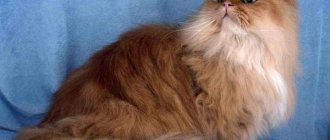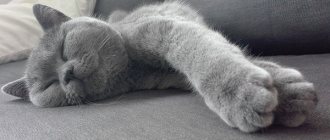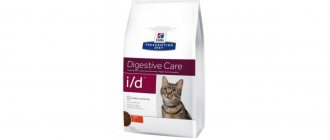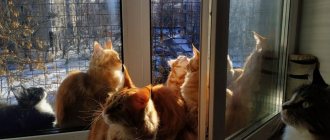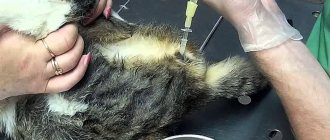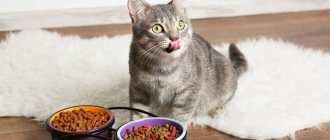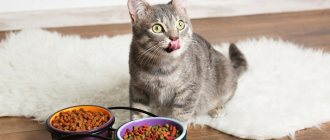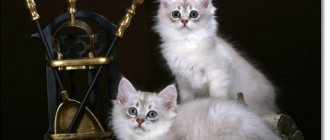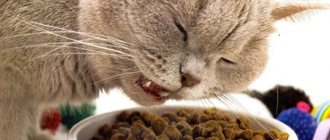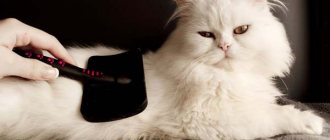Feeding your pet is one of the most important parts of caring for and raising a cat. In order for the animal to grow healthy, beautiful and cheerful, it is important to follow the rules of nutrition. Food must be balanced and contain all the necessary proteins, carbohydrates, and microelements to maintain the life of the pet.
Many owners sooner or later wonder: how to switch a cat to natural food?
Under natural conditions, cats hunt small rodents and reptiles. Contrary to popular belief, fish is a real delicacy on the cat table. It is quite difficult to catch her, knowing the complex relationship between the cat and the water element. In urban conditions, the animal cannot hunt, so the owner’s task is to provide the pet with vitamins as much as possible.
ATTENTION! When a pet switches to a natural diet, there should be no fundamental differences from the diet of animals that obtain food in natural conditions.
Why is it so difficult to wean a cat off ready-made food?
The composition of dry food, especially the line of economy class products, includes a large number of attractants and additives - special ingredients designed to attract the animal, enhance the taste and smell of food, causing persistent addiction to such food. These components are mixed into all feed without exception, especially in super-economy class products. Cats almost immediately become addicted to drugs by eating such food.
The absence of useful components is hidden by manufacturers through the introduction of such chemicals. They significantly worsen the condition of the teeth and fur of pets, cause damage to the psyche, and cause serious illnesses and allergic reactions.
Pros and cons of dry cat food
Any food has pros and cons, regardless of high or low quality. Knowing the positive and negative aspects of dry food, the pet owner will be able to correctly adjust his diet.
The advantages of dry food are:
- Cost-effective – the cost of premium-quality dry granulated food will cost the owner much less than feeding with high-quality natural products.
- Saving time - the owner does not need to constantly stock up on fresh meat and fish, as well as prepare meals for the pet.
- When feeding with high-quality feed, you don’t have to watch the diet. Dry food does not spoil when exposed to air. This is especially true in hot weather, when natural products in a cat’s bowl will spoil very quickly and can cause poisoning of the animal.
- Balance . High-quality granulated cat food meets all the necessary parameters of complete food for pets. In addition, food for kittens differs in quantitative composition from food for cats. When feeding an animal with natural food, it is necessary to strictly monitor and calculate the balance of nutrients necessary for growth and development, as well as microelements and vitamin complexes.
The disadvantages of cats are presented in the following list:
- Lack of moisture. All feeds, regardless of quality and manufacturing process, have a low percentage of required moisture. As a result of a violation of the water-salt balance, the animal may develop diseases of the internal organs. The urinary system is most often affected.
- Harmful to cat teeth. Manufacturers of some granular foods assure owners that dry food helps get rid of plaque on tooth enamel. This statement is nothing more than a myth. The effect of dry food on a cat's teeth is completely opposite - the predator does not have the necessary load on the teeth, which causes the formation of tartar.
- High carbohydrate content. This disadvantage applies exclusively to cheap granular feeds. In addition to harm to tooth enamel as a result of the increased content of carbohydrate elements in food, such food provokes a sharp increase in sugar levels in the systemic bloodstream, which can further lead to the development of diabetes mellitus.
The dangers of dry food
Often the true composition of a product is hidden by the manufacturer. Poor quality food often causes many side effects:
- poisoning with chemicals: dyes and flavors;
- the development of urolithiasis due to an excess of salts as preservatives, especially dangerous for neutered cats;
- the occurrence of vitamin deficiency due to the lack of necessary vitamins and microelements;
- heart failure, allergic reactions;
- Dysbacteriosis is the death of beneficial intestinal microflora, manifested by indigestion, metabolic disorders, skin and coat problems.
Types of ready-made food for kittens
Commercial cat food comes in several varieties. Types of food are canned, wet and dry. Thus, premium canned food for kittens contains all the necessary minerals and trace elements, as well as meat components, broth and vegetables.
Thanks to hermetically sealed packaging, pathogenic bacterial microorganisms do not penetrate into canned food. Canned food can replace natural food only if the quality is high.
Wet food for kittens is produced in special bags designed for 1 meal. Compared to canned food, the percentage of water in wet food is much less, so when feeding a kitten with wet food from spiders, it is necessary to observe a drinking regime.
Dry cat food is available in the form of granules containing processed grains, vegetables, meat and high-quality by-products. The amount of water in this type of food is unusually low, so it is important to provide the kitten with fresh drinking water in unlimited quantities. The advantage of dry food is that the shelf life of such food is much longer than the previous ones.
Transferring the cat to homemade food
You can continue to feed the animal its usual food, gradually mixing in various ingredients of another product until a complete replacement occurs. The new type of food should be given to the animal in small quantities in small pieces, no different in size from normal everyday food. After 4-5 days, the volume of dry food is reduced to 50%, then the replacement occurs completely within 10-15 days.
If the pet prefers certain products in addition to dry food, temporarily limit them only to them until the cat is completely weaned from “drying”.
If it is difficult to determine your pet’s taste preferences, it is worth offering several different dishes, placing them in different bowls. The cat will choose and take a liking to the new food, then the cat will be completely switched to homemade food.
There is an option when the volume of regular food is reduced, and the animal, without being completely full, is saturated with another product, homemade, located close to the main, regular food.
Usually, a cat’s refusal of new food plunges the owners into panic - they worry that the pet will become exhausted, get sick, or die. But the animal will not die of hunger if there is food nearby, even if it is tasteless and unloved. Fears are unfounded, remember that you are acting for the benefit of your pet, the cat will humble itself and accept your conditions.
At what age and how to transfer a kitten to dry food
Granular feed is easy to use and, compared to natural food, is not expensive. Dry food is balanced according to all necessary nutritional indicators. At what age should a kitten be switched to dry food, a veterinarian should advise after diagnostic tests and examination. As a rule, kittens are separated from their mother at the age of 1.5-2 months, and it is from this period that you can begin to accustom the baby to dry food.
Note! Switching a kitten to dry food too early can have a negative impact on the pet’s further development due to the underdevelopment of the bones that form the jaw.
You should also not rush into a sudden change in diet, especially if the pet initially received natural food. Experts recommend accustoming to a new type of diet for 14 days, adding a new type of food to the previous one in small portions. Every day, the portion of dry food should be gradually increased until it reaches 100%.
It is necessary to switch a kitten to adult food only after it shows a desire to chew on various objects. But in some cases, babies at the age of 4 weeks are already starting to try everything, which is associated with the eruption of baby teeth.
Advice from felinologists
Is it possible to quickly switch a cat to natural food, cat lovers will tell you:
- the addition of catnip facilitates faster adaptation to new food; over time, the supply is stopped, the animal gradually gets used to the food;
- several pieces of dry food are placed on the meat to give it a familiar smell, deceiving the cat;
- probiotics are useful during transition - feeding with dry food worsens peristalsis, lactobacilli improve the digestion process, the microflora is renewed, adaptation is easier;
- during the transition to natural food, vitamins are recommended;
- the bowl of food is removed after 15-20 minutes, regardless of whether there is food left in it or not.
Forbidden
The products presented below cannot be given during the transition to natural food, but also when the transition is finally completed.
- fatty foods, including lard;
- fried foods;
- confectionery;
- potatoes, cabbage, tomatoes;
- foods flavored with herbs or spices;
- animal bones, especially fish.
The general recommendation is not to give your pet food from the “home” table under any pretext.
Home feeding diet
The main product in this type of diet is meat, about 80%. The rest is cereals, vitamins, vegetable supplements. Natural feeding requires an accurate calculation of the daily food intake; the idea that the cat itself knows how much it needs to eat is wrong. Often, fluffy beauties, without knowing the limits, gobbling up delicious foods on both cheeks, acquire excess weight, heart and respiratory problems. Different ages are taken into account when compiling the daily menu.
How to calculate a kitten's nutritional intake
Two and a half months is the age at which a baby can be separated from its mother. Before nine months, the kitten should receive no more than 10% of its weight in food. With a weight of 2000 g, the weight of the daily portion is 200 g. 50% is meat food, 50% is fish products.
How to calculate the amount of food per day for an adult cat
An adult animal needs only 5% of its weight in feed. With an animal weighing 5 kg - 250 g of natural food, consisting of equal parts of fermented milk and meat products. 20 g of vegetables and a few drops of vegetable oil are allowed. Active pets, who expend a lot of energy, are given more food, inactive, obese, and elderly pets require less.
What can you give your cat?
The main components of natural cat food are:
- fish is a favorite product of fluffy beauties; marine varieties are recommended, both raw and boiled. Boiled fish should be cleaned of bones; they can be easily separated from the pulp; they can be swallowed unchewed or get stuck in the esophagus;
- meat - lean chicken, beef, lamb, rabbit, horse meat, scalded with boiling water, are allowed. Pork is banned;
- by-products - liver, lungs, heart, kidneys - are introduced into the diet 2 times a week - their nutritional value and usefulness are low. If there are signs of poor digestion: vomiting, diarrhea, by-products are excluded from the animal’s menu;
- fermented milk products - kefir, cottage cheese, medium-fat starters. Low-fat foods cause stool upset. Cats do not tolerate milk well - the number of enzymes that break down lactose decreases with age;
- vegetables - any are allowed: cabbage, carrots, peppers, pumpkin. A combination is possible. They are given in crushed raw form and can be mixed with meat. Potatoes - excluded;
- eggs - chicken or quail are suitable. The yolk and white are mixed. Serve separately or with kefir and cottage cheese.
A pet’s illness or surgery is a reason to contact a veterinarian to correct the animal’s nutrition.
Chicken necks have proven themselves well for natural feeding of cats. They are prepared as follows: mince twice through a meat grinder to grind hard bones, add a little boiled rice or buckwheat, and grated carrots. They mix.
Natural food is natural healthy nutrition for your feline. With good care, a kind attitude, a positive attitude of the owners, and a well-designed feeding diet, the animal will be healthy, happy, and will live a long, fulfilling life next to its owners.
What is artificial food?
They write a lot about them, they also talk a lot, but they talk mainly about which class of food is better - premium or economy? It is not often discussed whether there is a need to feed a cat artificial food. Whatever one may say, lazy owners buy canned food and “crackers” for pets. Yes, yes, let's call everything by its proper name. Isn't that true? First of all, we try to take care of ourselves by getting rid of the fiction of “what should I feed the cat today?” The easiest way is to buy a jar of canned food, open it and pour it into a bowl.
In addition, thanks to advertising that contributes to the growth of popularity, our concept of a proper cat diet has been distorted to “I can’t.” Advertising “educates” us about the value of cereals and other silage for what is essentially a carnivorous animal.
